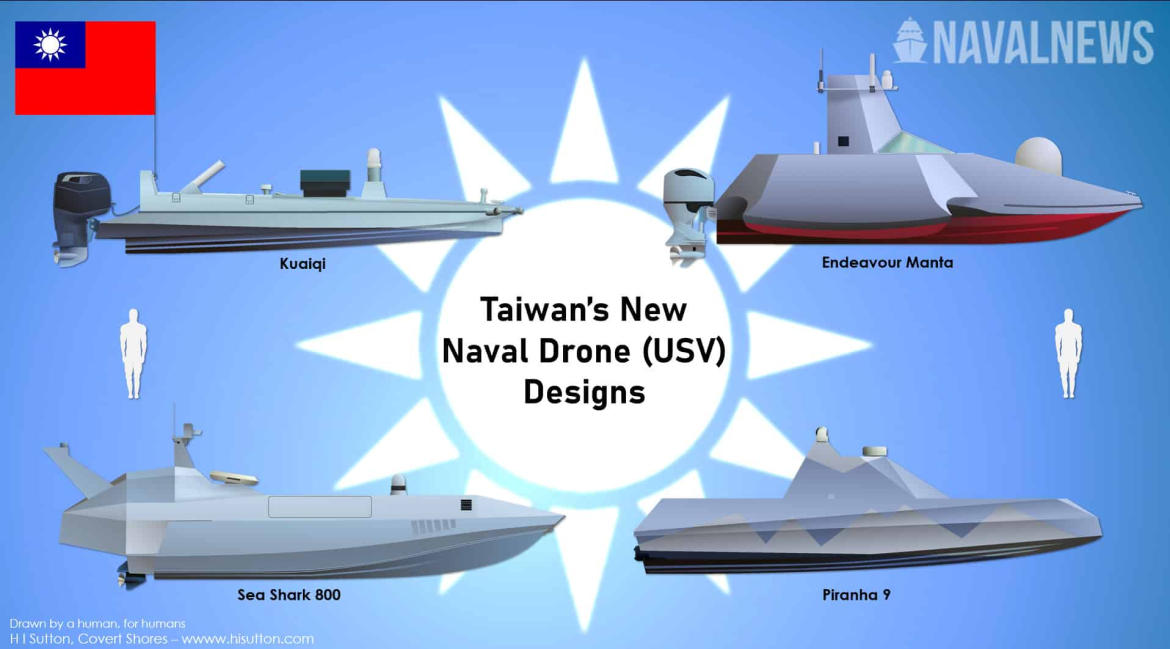Taiwan is now rapidly developing a naval drone capability. Several types have been seen being trialled with a range of armaments. These vessels, known as USVs, could enable Taiwan to disrupt and weaken an invasion fleet headed for the island.
Facing the threat of invasion, Taiwan is increasing the pace of its defensive build-up. One very visible aspect is the development of armed uncrewed surface drones (USVs). These are heavily influenced by the lessons of the Russo-Ukraine War in the Black Sea. Ukraine has achieved unprecedented success, denying the larger Russian fleet Sea Control in the Black Sea. Taiwan has clearly been taking notes.
Few individual weapons are war winning, and the threat from mainland China (PRC) is nuanced, but these could make a difference. They might disrupt and weaken an initial invasion wave, and impose a high cost on resupplying any beachhead. The now famous invasion barges, first reported by Naval News, would be high on the target list. And used creatively, they could shape PRC ship movements and expose them to other defences such as long range missiles.
Rapid Development
It is now almost 3 years since Ukraine’s USVs first burst onto the scene with a bold raid on Sevastopol. Taiwan showed the first hints of following Ukraine’s lead less than a year later when, in August 2023, the Sea Shark 400 surface drone was unveiled. That craft was small and lightweight, more capable systems would be needed. Things appeared slow after that, but recently in June this year the first wave of war-fighting designs was demonstrated. An event, organised by the National Chung-Shan Institute of Science & Technology (NCSIST), involved 12 companies.
Now the pace has visibly quickened. Public reporting indicates that trials of batches of USVs is underway. It is likely that some developments remain under wraps, yet much of development is in the open.
Taiwan’s Naval Drones
The vessel which closest matches the Ukrainian designs is the Kuaiqi. Developed from the ‘Black Tide’ demonstrator seen in the June event, it features a low profile hull. Two Cox diesel outboards provide the power giving a reported performance of 43 knots. It has been seen with Kymeta satellite communications and a range of weapons including an explosive ‘ram charge’ in the bow, a hangar for quadrotor drones, and six launch tubes for loitering munitions. The latter are likely the indigenous Jing Feng type, an analogue of the American Switchblade design.
A more futuristic design is the Endeavour Manta. A trimaran with faceted stealthy fiber-reinforced plastic hull, it is 8.6 meters (28 feet) long and 3.7 meters (12 feet) across. It is optionally crewed with a small cockpit in the base of its sail-like mast. A conspicuous radome, possibly for a gimbal mounted satellite communications dish, dominates the forward deck. Two Honda outboard motors allow for 35 knots top speed.
The Sea Shark 800 is a much larger follow on from the original -400 concept. This is a motorboat with twin outboards which, unusually, are complete encased. This likely offers some degree of armour.
The Piranha 9, as the name suggests, is a 9 meter (29 foot) design with stealth lines and a comparatively large superstructure amidships. This houses the drone hangar for loitering munitions. The vessel is powered by twin inboard motors driving water jets. Notably, the hull is coated in radar absorbent material (RAM).
Outlook
It remains to be seen whether Taiwan’s new USVs will be enough to deter PRC landings. Starting wars is after all a principally political decision. But their presence in Taiwan could add to the uncertainty for Beijing’s military planners. Especially if they can be built and deployed in numbers and operational patterns and capabilities can remain secret. It increases Beijing’s risk calculus and may just be the weapon that gives an invasion fleet a bloody nose.

